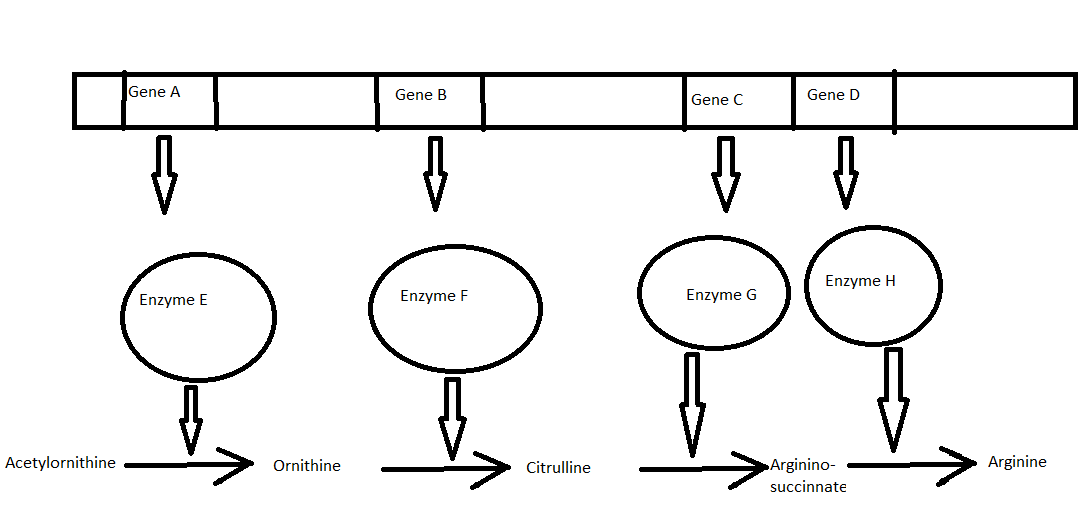
On which organism Beadle and Tatum Worked to propose one gene-one enzyme hypothesis?
A) Drosophila
B) Escherichia coli
C) Neurospora crassa
D) Nostoc
Answer
474k+ views
Hint: One gene-one enzyme hypothesis was proposed in 1941 by Beadle and Tatum. The idea behind this was that each gene codes for an individual enzyme and thus impacts a specific step in a metabolic pathway.
Complete answer: Beadle and Tatum did their experiment on the fungus Neurospora crassa. They observed that a substrate changes to intermediate substrate 1 and intermediate substrate 2 before changing to the end product. And each step requires a specific enzyme. They expose the culture of Neurospora to the X – rays. Due to this, a small change in the DNA of the Neurospora occurred. This culture is then mixed with a non-mutated strain. These two strains produce the spores. These spores are grown in the complete culture media containing salts, sucrose, and a mixture of vitamins, amino acids, and other growth factors. Both types of spores (wild and mutant types) grow in the media. Then these spores are transferred to the minimal culture containing salt and sugar but no amino acid or growth factors. In this case, wild types grow on minimal media because they are capable of synthesizing the required amino acid and growth regulators. But mutant type did not grow in minimal media. Its major contribution is in molecular genetics.

Thus, the correct answer is option (C).
Note: Modern understanding (Major exception of one gene one enzyme hypothesis):
1) Many genes encode non-enzyme proteins. Protein like Insulin which is a signaling hormone, protein-like keratin which is a structural protein, Transport protein like haemoglobin, and also protein like antibiotics which helps to fight against pathogens.
2) Many proteins are composed of more than one polypeptide, each coded by a separate gene.
3) There are many genes that code for various types of non-coding RNAs. Example genes that code for rRNA (show catalytic properties), tRNA (they transfer RNA that brings amino acid to the ribosomes), and the regulatory RNAs.
4) Many multi-exonic genes produce transcripts that are alternatively spliced, producing many different proteins from one gene.
Complete answer: Beadle and Tatum did their experiment on the fungus Neurospora crassa. They observed that a substrate changes to intermediate substrate 1 and intermediate substrate 2 before changing to the end product. And each step requires a specific enzyme. They expose the culture of Neurospora to the X – rays. Due to this, a small change in the DNA of the Neurospora occurred. This culture is then mixed with a non-mutated strain. These two strains produce the spores. These spores are grown in the complete culture media containing salts, sucrose, and a mixture of vitamins, amino acids, and other growth factors. Both types of spores (wild and mutant types) grow in the media. Then these spores are transferred to the minimal culture containing salt and sugar but no amino acid or growth factors. In this case, wild types grow on minimal media because they are capable of synthesizing the required amino acid and growth regulators. But mutant type did not grow in minimal media. Its major contribution is in molecular genetics.

Thus, the correct answer is option (C).
Note: Modern understanding (Major exception of one gene one enzyme hypothesis):
1) Many genes encode non-enzyme proteins. Protein like Insulin which is a signaling hormone, protein-like keratin which is a structural protein, Transport protein like haemoglobin, and also protein like antibiotics which helps to fight against pathogens.
2) Many proteins are composed of more than one polypeptide, each coded by a separate gene.
3) There are many genes that code for various types of non-coding RNAs. Example genes that code for rRNA (show catalytic properties), tRNA (they transfer RNA that brings amino acid to the ribosomes), and the regulatory RNAs.
4) Many multi-exonic genes produce transcripts that are alternatively spliced, producing many different proteins from one gene.
Recently Updated Pages
Master Class 9 General Knowledge: Engaging Questions & Answers for Success

Master Class 9 English: Engaging Questions & Answers for Success

Master Class 9 Science: Engaging Questions & Answers for Success

Master Class 9 Social Science: Engaging Questions & Answers for Success

Master Class 9 Maths: Engaging Questions & Answers for Success

Class 9 Question and Answer - Your Ultimate Solutions Guide

Trending doubts
Give 10 examples of unisexual and bisexual flowers

Draw a labelled sketch of the human eye class 12 physics CBSE

Differentiate between homogeneous and heterogeneous class 12 chemistry CBSE

Differentiate between insitu conservation and exsitu class 12 biology CBSE

What are the major means of transport Explain each class 12 social science CBSE

Why is the cell called the structural and functional class 12 biology CBSE




